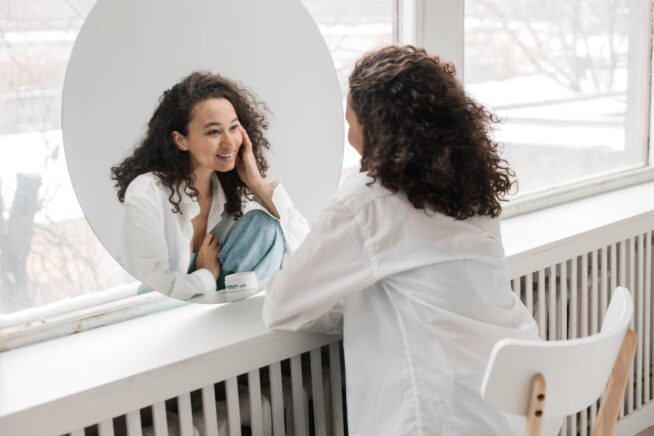If you’ve been quarantining for a while, you are probably tired of looking at your own face. People are experiencing “Zoom exhaustion” from the full-frontal exposure of their own and other people’s faces of increased size, intensity, and duration. You might also feel like you are under a microscope, because in a way you are. If you look away, yawn, or avert your gaze for even a few seconds, it’s instantly apparent to everyone. In-person meetings rarely require that we face others at this magnitude, nor do they require that we continuously see ourselves in the background.
Or maybe it’s just passing by that mirror in your living space for the hundredth time in a day. Especially if you’ve been quarantining alone, you’ve likely been seeing yourself more than usual.
So here’s some surprising news, which happens to be supported by research: If you’re feeling loneliness, insecurity, or despair — three common features of the current pandemic — one solution is to look at yourself more, not less. You can start by looking into your mirror.
If you believe that gazing into a mirror often increases discomfort, well, you’re right. But doing the opposite of what makes you comfortable can have real benefits.
As a research scientist, I’ve been exploring how mirrors and reflections influence our psychological states – particularly how people navigate the self-consciousness activated by seeing their reflection. Contrary to the myth of Narcissus, most people do not instantly fall in love with their image. The mirror orients our perception to how others see us. We often reflexively find flaws in our appearance when we take this perspective.
In self-recognition studies, experimenters stealthily place a dot on a child’s forehead. When children see their reflection and try to remove the mark, it’s inferred that they have developed a sense of self because they can recognize themselves in the mirror. Seeing the dot also commonly produces feelings of shame and embarrassment — similar to spotting a smudge on your face or spinach in your teeth. In this way, shame and embarrassment can become associated with mirrors. People may go to great lengths to dodge looking at themselves in an attempt to avoid these unpleasant states of self-consciousness that often produce self-critical emotions.
But that’s why looking into a mirror is important.
In our experiments, participants sit in front of a mirror for 10 minutes or more without any specific goals or instructions – simply being with themselves and experiencing whatever arises. They follow the general principles of mindfulness meditation — keeping your attention in the present moment, maintaining an open awareness of what you are experiencing, and having a kind intention toward yourself. By confronting their image in this way, they become more aware of their discomfort from simply being with themselves. And they become more aware of their emotions.
A research participant in our meditation study whom I’ll call Carly is an excellent example of how we commonly experience discomfort from seeing ourselves. As Carly sat with herself in front of the mirror, she had the persistent urge to mitigate the intensity by diverting her attention to checking her phone or reaching for a snack in her bag. She wanted to critique her appearance, suck in her stomach, and adjust her hair and clothing. She also looked to the experimenter for affirmation that she was doing it right, and secretly planned what she was going to do once the experiment session was over.
Without any structure or script, her attention ping-ponged from one topic to another in an attempt to avoid the emotional intensity of seeing herself. In general, face-to-face contact provides a lot of information about emotions. Developmental psychologists find that we learn how to display and regulate our emotions through the feedback and reflection we receive during early face-to-face interaction. So what happens when we have face-to-face contact with ourselves? For one thing, it often externalizes what’s going on inside us. In Carly’s case, the mirror reflected her discomfort and impatience. The more she looked at herself, the more uncomfortable and impatient she felt. Her self-mirroring created a feedback loop that intensified her experience.
I asked Carly to shift her attention to what is called a meta-cognitive perspective in which we become aware of how we are thinking and perceiving as we are doing it. When she was able to step back and observe herself, her self-awareness increased, and she started to realize how unkind she was to herself. She’d been hiding from and ignoring herself, especially when she was in emotional pain and distress. As Carly continued to practice the mirror meditation, she got better at being with herself and tolerating her feelings. As she observed herself, she learned more about how her thoughts created different emotions.
Research shows that one of the most effective ways to dismantle self-criticism, or the voice in your head known as “the inner critic,” is to change your perspective in this way. Mirrors accelerate the process in both directions: They can either intensify the pain of self-criticism or provide a means to treat ourselves more kindly. Studies have found that mirrors can boost the effects of compassionate self-talk. Participants who said the self-compassionate phrases in the mirror reported higher levels of soothing, positive emotions compared to participants who said the phrases without the mirror. They also had more heart rate variability (HRV), which is an indicator of the ability to regulate one’s emotions and physiological response. Our sense of self is inherently linked to our own face; looking at our own eyes and face while experiencing self-compassion toward ourselves can profoundly impact our psychophysiology and reduce our distress.
Now that we are seeing ourselves and others with greater intensity and under anxiety-provoking circumstances, the mirror may help you get more comfortable with being with yourself and accepting and understanding your emotion with compassion.
 Dr. Tara Well is a psychology professor at Barnard College in New York City where she developed a mirror-based meditation called “a revelation” in the New York Times. She has taught hundreds of people how to use the mirror to awaken self-compassion, manage emotions, and improve face-to-face communication. Find out more at www.MirrorMeditation.com
Dr. Tara Well is a psychology professor at Barnard College in New York City where she developed a mirror-based meditation called “a revelation” in the New York Times. She has taught hundreds of people how to use the mirror to awaken self-compassion, manage emotions, and improve face-to-face communication. Find out more at www.MirrorMeditation.com
Image courtesy of Pavil Danilyuk.












